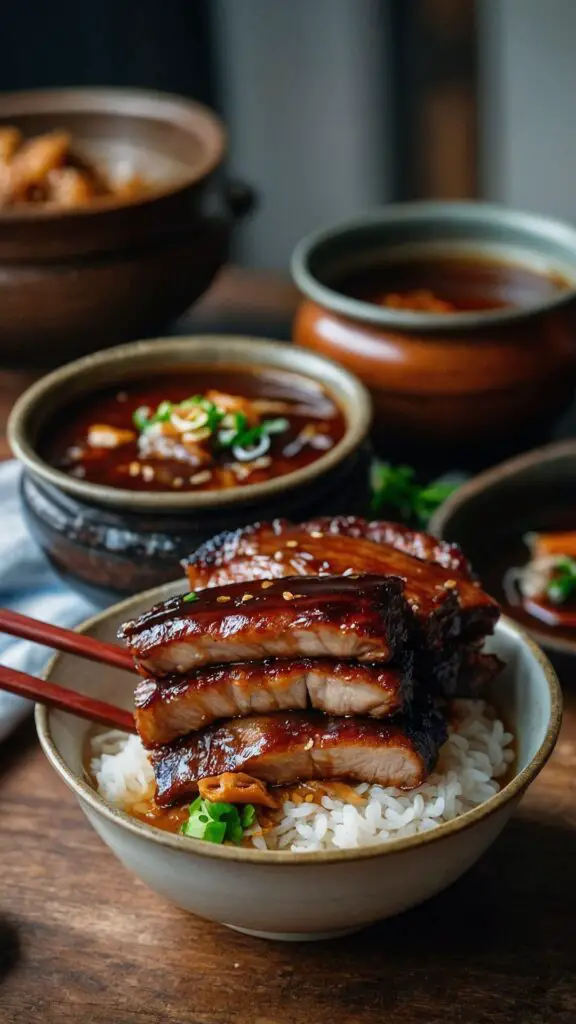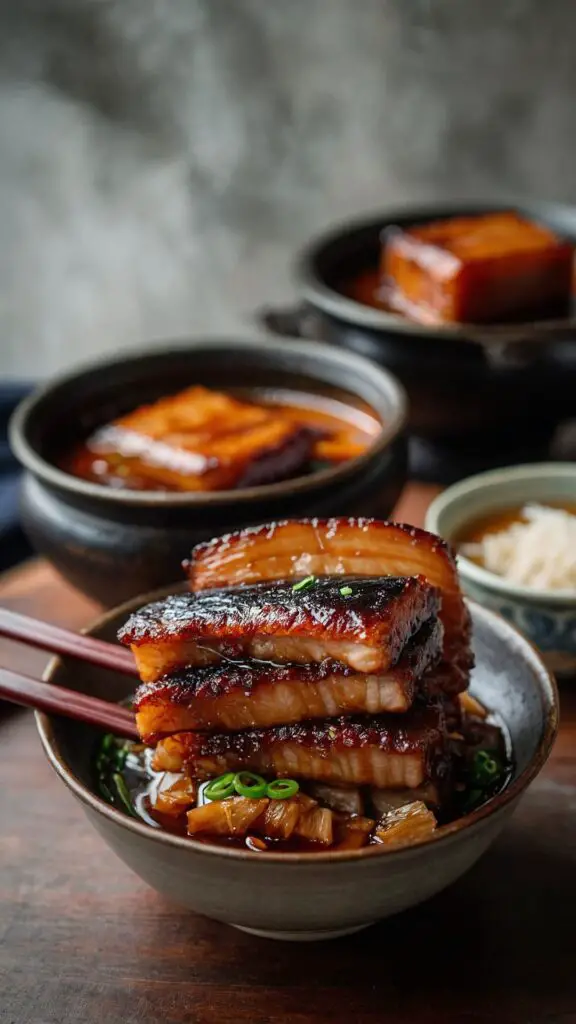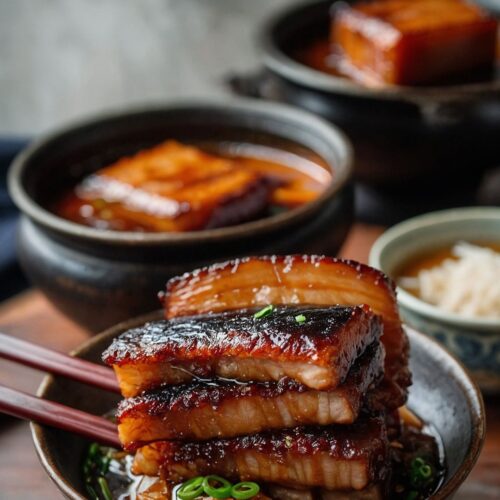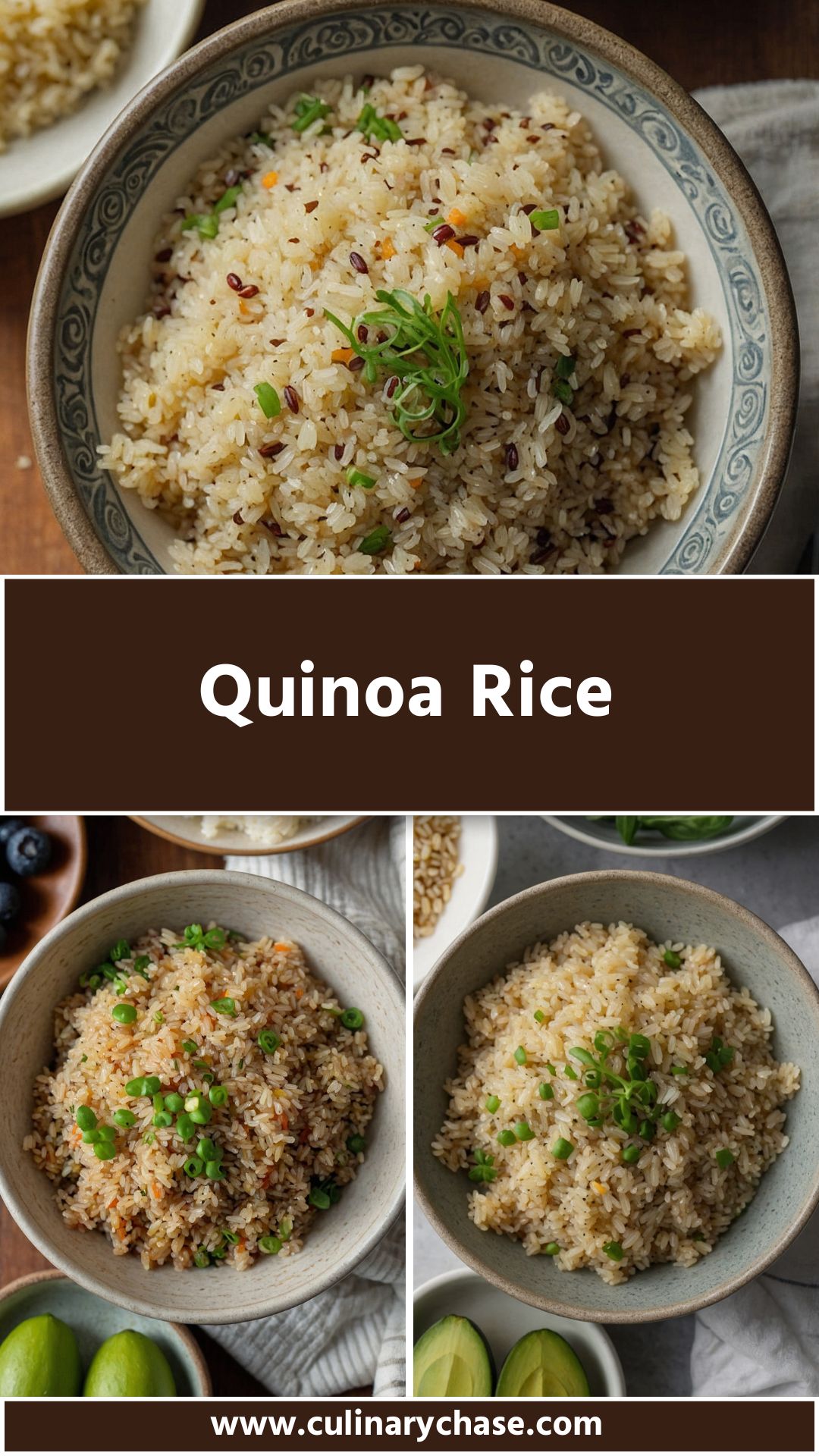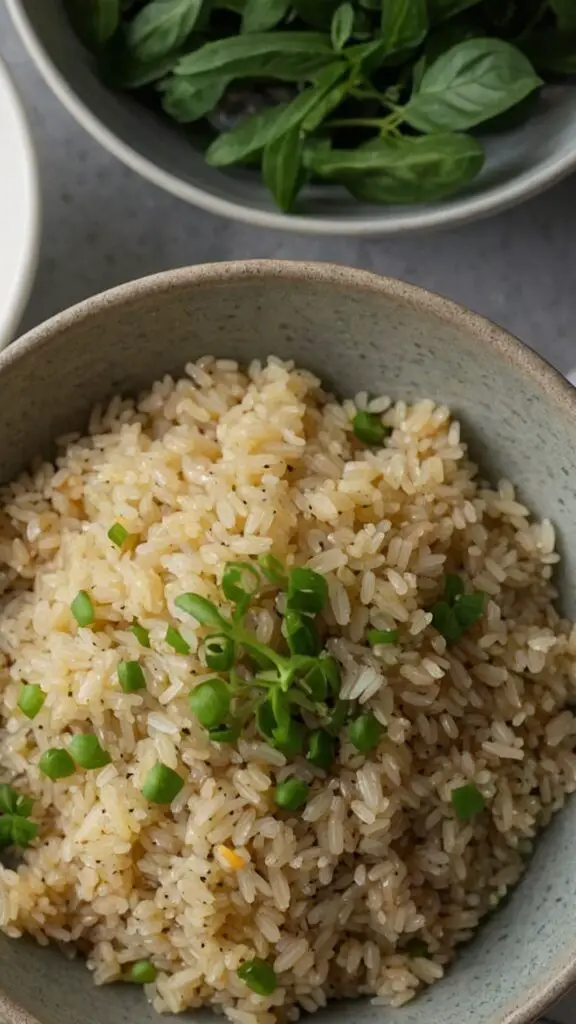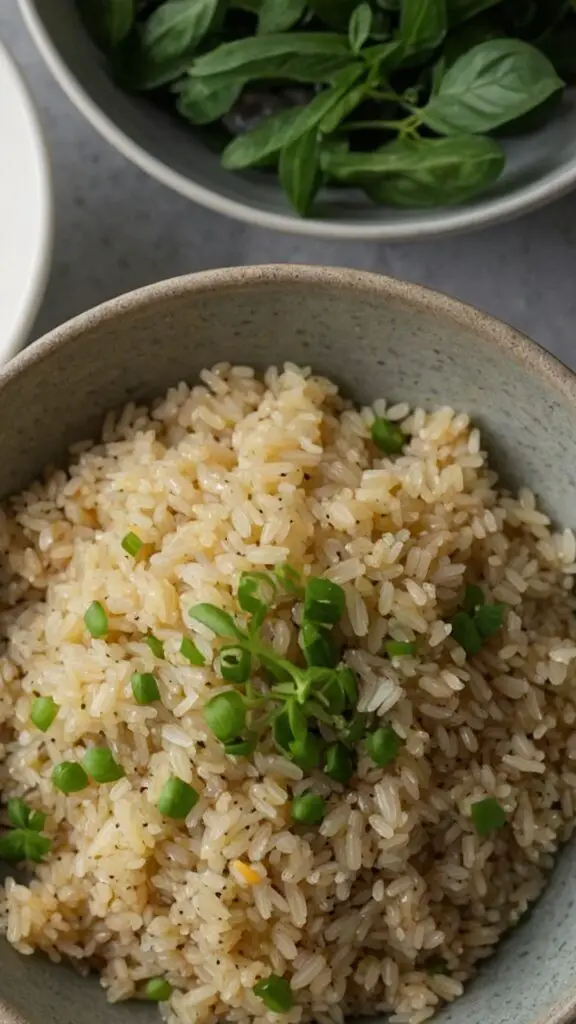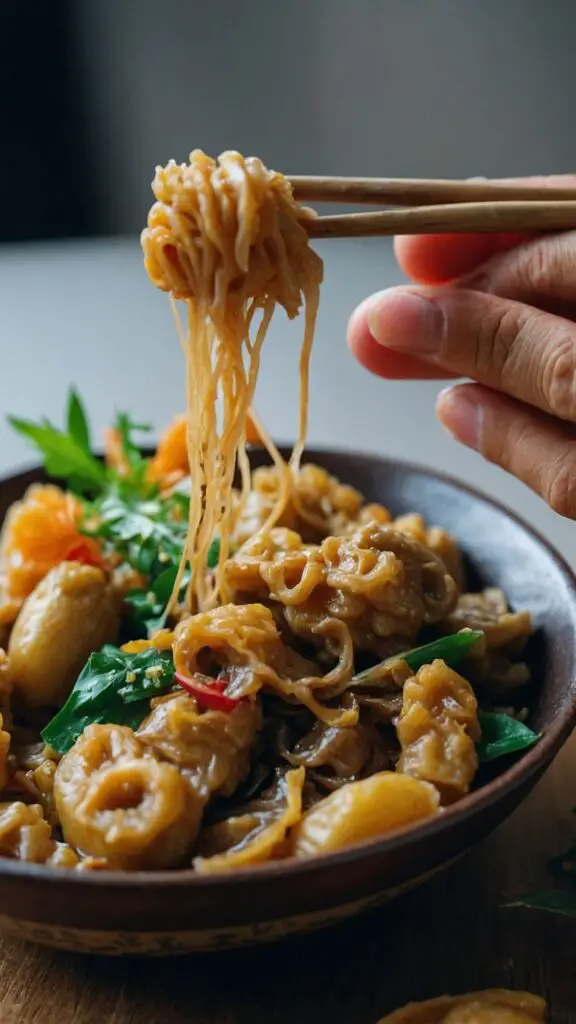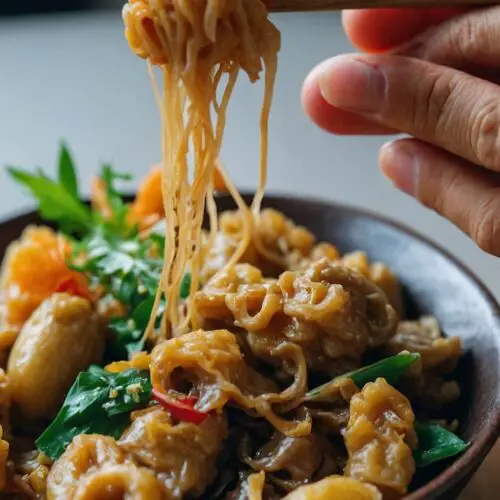Before diving into the delightful world of Buddha’s Delight Lo Han Jai, let’s talk about what to serve alongside this intricate dish. A light, fragrant jasmine rice pairs beautifully, soaking up the medley of flavors from the main dish.
Alternatively, a simple vegetable broth or miso soup can complement it well. For a crunchy element, consider a side of cool cucumber salad sprinkled with sesame seeds. This helps balance the hearty textures and flavors found in Lo Han Jai, ensuring a fulfilling dining experience.
Let’s journey together into the heart of a beautiful dish. Picture a vibrant medley of vegetables, mushrooms, and delightful textures all swirling around in a pot. That’s Buddha’s Delight Lo Han Jai for you—a true gem in Chinese vegetarian cuisine.
It’s not just food; it’s a celebration of flavors, joyfully blending tradition with nutrition in every bite. This dish isn’t merely for vegetarians or vegans; it’s for anyone wanting a taste journey that leaves their taste buds dancing.
Honestly, when I first tried Buddha’s Delight, I was captivated. The textures, the colors, the flavors—it all felt magical. Over the years, I’ve honed my recipe and found ways to share it, and I can confidently say it’s now easier than ever to recreate at home. Let’s explore this treasure together, shall we?
What is Buddha’s Delight Lo Han Jai?
Buddha’s Delight, or Lo Han Jai, is an ancient vegetarian dish popular in Chinese culture. Traditionally served during the Lunar New Year, it’s said to bring good fortune. This recipe is usually made with a combination of six or more different vegetables and ingredients, reflecting prosperity and abundance.
You’ll find an array of dried ingredients and fresh vegetables in this dish. It’s a hearty mix featuring shiitake mushrooms, black fungus, and cellophane noodles, among other components. This is food that warms the soul as well as the stomach. Each ingredient has significance, including the auspicious jujubes or red dates, believed to bring happiness.
What is the Flavor Profile of This Dish?
Imagine biting into a diverse palette of flavors and textures. Each spoonful brings a balance of savory, slightly sweet, and earthy notes. The shiitake mushrooms provide umami, while the black moss adds a hint of earthiness. The fresh vegetables deliver a crisp contrast to the chewy textures of the dried ingredients.
The dish achieves a delightful depth from the combination of soy sauces and rice wine. Meanwhile, the red fermented bean curd introduces a distinctive savory element, melding harmoniously with toasted sesame oil’s nuttiness. Overall, it’s a flavor journey that evolves in each mouthful.
You will also like the following Side Dishes recipes!
What Makes This Recipe Different from Other Buddha’s Delight Lo Han Jai?
While traditional recipes exist, my approach to Buddha’s Delight embraces accessibility and flavor without compromising authenticity. I use a variety of vegetables that culminate in a rich and satisfying dish. My version draws from personal experience, using fresh ingredients whenever possible while respecting the dish’s roots.
Unlike some recipes that can be overly simplistic or bland, this one features multiple textures and flavors, ensuring a genuine experience that transports you straight to your favorite Chinese restaurant. My tweaks offer you the chance to prepare a restaurant-quality dish right in your kitchen.
Ingredients You’ll Need
For a dish as rich as Buddha’s Delight, selecting the right ingredients is key. Here’s what you’ll need:
Dried Ingredients
- 12 dried red jujubes (red dates): Sweet and nutritious.
- 50 g cellophane noodles (1 bundle): For a delightful chewy texture.
- 10 g dried wood ear mushrooms (black fungus): For a unique crunch.
- 3 g dried black moss (fat choy): Adds visual appeal and earthy flavor.
- 10 g dried lily buds (lily flowers): Delicate yet flavorful.
- 60 g dried shiitake mushrooms (approximately 10–12 pieces): Packed with umami.
Aromatics
- 3 spring onions (scallions), trimmed: Fresh and mild.
- 5 cm piece of fresh ginger, sliced: Provides warmth and zest.
- 2 garlic cloves, smashed: Essential for depth of flavor.
Vegetables
- 1 medium carrot, peeled and sliced: Sweet and crunchy.
- ½ small napa cabbage, chopped: Soft and mild.
- 2 bunches of pak choi, washed and halved: Adds color and crispness.
Braising Liquid
- 125 ml shiitake mushroom soaking water: Infuses rich flavor.
- 125 ml lily flower soaking water: Adds another layer of depth.
- 2 tablespoons Shaoxing rice wine (or substitute with any rice wine, dry sherry, or ½ teaspoon clear vinegar for alcohol-free).
- ½ teaspoon salt: Enhances all the flavors.
- 1 teaspoon white sugar: To balance flavors.
- 2 tablespoons light soy sauce: A classic salty profile.
- 1 tablespoon dark soy sauce: For color and extra depth.
Remaining Ingredients
- 3 heaping tablespoons red fermented bean curd: Unique umami flavor.
- 1 tablespoon toasted sesame oil: Enriches the dish with nuttiness.
- 1 tablespoon vegetable oil: For cooking.
- 30 g gingko nuts (or 60 g / 2 oz if preferred): Traditional and adds a nice texture.
- 100 g fried tofu puffs: Adds protein and heartiness.
- 1 small dried star anise—added for a subtle aromatic depth.
Step by Step Directions
Crafting Buddha’s Delight Lo Han Jai is an adventure that indulges your senses. Follow these steps for a rewarding cooking experience.
Step 1: Preparing Dried Ingredients
Start by soaking the dried ingredients. In separate bowls, soak the shiitake mushrooms, lily buds, and black moss for about 30 minutes. The wood ear mushrooms should also be soaked until they soften. This has them ready for cooking and enhances their flavors.
Step 2: Preparing Fresh Ingredients
While your dried ingredients are soaking, prep your fresh ones. Chop the napa cabbage, carrot, and pak choi. Slice the ginger and garlic. This will streamline your cooking process.
Step 3: Stir Frying
In a deep wok or large saucepan, heat the vegetable oil over medium heat. Add ginger and garlic, stirring for about a minute until they become fragrant. Toss in the soaked dried ingredients—shiitake mushrooms, wood ear mushrooms, and lily buds—and stir-fry for an additional 3 to 4 minutes.
Step 4: Adding Vegetables
Now, add the chopped napa cabbage and carrot to the pan. Stir frequently until they soften slightly, which should take about 5 minutes. Then, add the pak choi. Keep cooking until everything is well-mixed.
Step 5: Mixing the Braising Liquid
In a separate bowl, mix together the soaking water from the shiitake mushrooms, lily flower, soy sauces, rice wine, sugar, and salt. Pour this mixture over your stir-fried ingredients.
Step 6: Adding Remaining Ingredients
Add the cellophane noodles and stir well to ensure they are covered in the braising liquid. Let it simmer on low heat for about 10-15 minutes. This will allow all the flavors to meld beautifully!
Step 7: Final Touches
Towards the end, fold in the fried tofu puffs, red fermented bean curd, gingko nuts, and sesame oil. Cook for 5 more minutes. You want everything heated through and well-combined.
Step 8: Serve
Serve the Buddha’s Delight over a bed of jasmine rice or on its own. This dish is amazing hot but can also shine the next day as leftovers—if there are any left!
Tips On Making Buddha’s Delight Lo Han Jai
Soak Wisely: Make sure to soak your dried ingredients long enough. This enhances their flavors and textures.
Don’t Rush Cooking: Allow each ingredient to properly soften and absorb flavors during the cooking process.
Balance Flavors: Taste as you go. You may prefer more soy sauce or a hint of sweetness; adjust according to your taste.
Experiment with Vegetables: Feel free to add other vegetables like bell peppers or zucchini. Use what you have on hand!
Use Fresh Ingredients: Fresh vegetables not only enhance flavor but also add vital nutrients.
Nutrition Information
One serving of Buddha’s Delight Lo Han Jai is packed with essential nutrients. Here’s a quick breakdown:
Calories: 210
Protein: 12g
Fat: 8g
Carbohydrates: 29g
Fiber: 6g
Sugar: 5g
These values may vary based on portion size and specific ingredients used but provide a solid overview of the dish’s nutritional profile.
How Can I Store This Buddha’s Delight Lo Han Jai?
If you find yourself with leftovers (which, let’s face it, is always a good thing), store Buddha’s Delight in an airtight container in the refrigerator. It keeps well for about 3-4 days. For longer storage, consider freezing the dish. It will last for about a month in the freezer. Just reheat it on the stovetop, adding a splash of water to bring back some moisture.
Substitute Options
If you’re lacking some ingredients, don’t fret! Here are some substitutes that can save the day:
Cellophane Noodles: If these are hard to find, you can use rice noodles or even thin spaghetti. Just cook them accordingly as they might require different cooking times.
Dried Shiitake Mushrooms: Can’t find them? You can swap them with baby bella mushrooms. They provide a similar flavor profile.
Red Fermented Bean Curd: In a pinch, try using miso paste or soy sauce. Although they won’t mimic the exact flavor, they add a savory touch.
Dried Black Moss: If you can’t find this ingredient, simply omit it or substitute with chopped, fresh greens for texture.
Buddha’s Delight Lo Han Jai
Before diving into the delightful world of Buddha's Delight Lo Han Jai, let's talk about what to serve alongside this intricate dish.
Prep Time 30 minutes mins
Cook Time 15 minutes mins
Soaking Time: 30 minutes mins
Total Time 1 hour hr 15 minutes mins
Course Side Dish
Cuisine Chinese
Servings 8
Calories 210 kcal
Dried Ingredients
- 12 dried red jujubes red dates: Sweet and nutritious.
- 50 g cellophane noodles 1 bundle: For a delightful chewy texture.
- 10 g dried wood ear mushrooms black fungus: For a unique crunch.
- 3 g dried black moss fat choy: Adds visual appeal and earthy flavor.
- 10 g dried lily buds lily flowers: Delicate yet flavorful.
- 60 g dried shiitake mushrooms approximately 10–12 pieces: Packed with umami.
Aromatics
- 3 spring onions scallions, trimmed: Fresh and mild.
- 5 cm piece of fresh ginger sliced: Provides warmth and zest.
- 2 garlic cloves smashed: Essential for depth of flavor.
Vegetables
- 1 medium carrot peeled and sliced: Sweet and crunchy.
- ½ small napa cabbage chopped: Soft and mild.
- 2 bunches of pak choi washed and halved: Adds color and crispness.
Braising Liquid
- 125 ml shiitake mushroom soaking water: Infuses rich flavor.
- 125 ml lily flower soaking water: Adds another layer of depth.
- 2 tablespoons Shaoxing rice wine or substitute with any rice wine, dry sherry, or ½ teaspoon clear vinegar for alcohol-free.
- ½ teaspoon salt: Enhances all the flavors.
- 1 teaspoon white sugar: To balance flavors.
- 2 tablespoons light soy sauce: A classic salty profile.
- 1 tablespoon dark soy sauce: For color and extra depth.
Remaining Ingredients
- 3 heaping tablespoons red fermented bean curd: Unique umami flavor.
- 1 tablespoon toasted sesame oil: Enriches the dish with nuttiness.
- 1 tablespoon vegetable oil: For cooking.
- 30 g gingko nuts or 60 g / 2 oz if preferred: Traditional and adds a nice texture.
- 100 g fried tofu puffs: Adds protein and heartiness.
- 1 small dried star anise—added for a subtle aromatic depth.
Step 1: Preparing Dried Ingredients
Start by soaking the dried ingredients. In separate bowls, soak the shiitake mushrooms, lily buds, and black moss for about 30 minutes. The wood ear mushrooms should also be soaked until they soften. This has them ready for cooking and enhances their flavors.
Step 2: Preparing Fresh Ingredients
While your dried ingredients are soaking, prep your fresh ones. Chop the napa cabbage, carrot, and pak choi. Slice the ginger and garlic. This will streamline your cooking process.
Step 3: Stir Frying
In a deep wok or large saucepan, heat the vegetable oil over medium heat. Add ginger and garlic, stirring for about a minute until they become fragrant. Toss in the soaked dried ingredients—shiitake mushrooms, wood ear mushrooms, and lily buds—and stir-fry for an additional 3 to 4 minutes.
Step 4: Adding Vegetables
Now, add the chopped napa cabbage and carrot to the pan. Stir frequently until they soften slightly, which should take about 5 minutes. Then, add the pak choi. Keep cooking until everything is well-mixed.
Step 5: Mixing the Braising Liquid
In a separate bowl, mix together the soaking water from the shiitake mushrooms, lily flower, soy sauces, rice wine, sugar, and salt. Pour this mixture over your stir-fried ingredients.
Step 6: Adding Remaining Ingredients
Step 7: Final Touches
Towards the end, fold in the fried tofu puffs, red fermented bean curd, gingko nuts, and sesame oil. Cook for 5 more minutes. You want everything heated through and well-combined.
- Soak Wisely: Make sure to soak your dried ingredients long enough. This enhances their flavors and textures.
- Don’t Rush Cooking: Allow each ingredient to properly soften and absorb flavors during the cooking process.
- Balance Flavors: Taste as you go. You may prefer more soy sauce or a hint of sweetness; adjust according to your taste.
- Experiment with Vegetables: Feel free to add other vegetables like bell peppers or zucchini. Use what you have on hand!
- Use Fresh Ingredients: Fresh vegetables not only enhance flavor but also add vital nutrients.
Calories: 210kcalCarbohydrates: 29gProtein: 12gFiber: 6gSugar: 5g
Keyword Buddha’s Delight Lo Han Jai
Frequently Asked Questions
1. Can I add meat to Buddha’s Delight?
Yes, feel free to add proteins like chicken or shrimp if you wish. Just cook them first and set aside when preparing the dish. Add them back in once the veggies are tender.
2. Is this dish vegan?
Absolutely! All ingredients in this version are plant-based. It’s suitable for those following a vegan diet.
3. Can I make this dish gluten-free?
Yes, simply use gluten-free soy sauce or tamari when preparing the dish. Cellophane noodles are usually gluten-free, so you’re in luck!
4. What’s the best way to prepare leftovers?
Reheat leftovers in a pan or microwave, adding a splash of water or broth. This helps retain moisture and prevents drying out.
5. Is Buddha’s Delight healthy?
Certainly! This dish features plenty of vegetables, plant-based proteins, and minimal oil, making it a healthy option compared to many other dishes.
Conclusion
Buddha’s Delight Lo Han Jai represents harmony on a plate. With each ingredient playing a pivotal role, this dish tells a story of tradition, health, and flavor. The textures and layers create more than just a meal; they craft an experience worth sharing.
As you venture into making this dish, remember that cooking is about joy and exploration. Don’t hesitate to experiment—after all, that’s how the best recipes come to life. I hope this guide empowers you not just to recreate Buddha’s Delight but to cultivate an appreciation for the simplicity and richness it offers. Here’s to making lasting memories around the dinner table, one delightful bite at a time!
You’ll also like these latest recipes!





